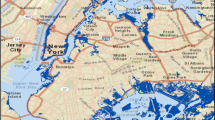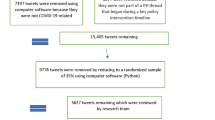Abstract
A growing number of citizens and local governments are using tweets to communicate during natural disasters. A good understanding of the communication contents and behaviors is critical for disaster relief. Previous work has used crisis taxonomies or manually labeling methods to understand the content. However, such methods usually require extra efforts to find insights related to specific events. In this paper, we use a semi-automatic framework to extract specific topics from the communication contents of citizens and local governments, combined with the spatiotemporal information to explore: 1) the spatiotemporal bursts of topics; 2) the change of topics with respect to the severity of disaster; and 3) communication behaviors. We use tweets collected during 18 snowstorms in the State of Maryland, US, as a case to study. The study reveals the communication differences due to the urban-rural divide or to the severity of the snowstorms. The insights suggest that local governments could potentially adapt the context of information delivered to citizens so as to match their needs.






Similar content being viewed by others
References
Acar, A., & Muraki, Y. (2011). Twitter for crisis communication: lessons learned from Japan's tsunami disaster. International Journal of Web Based Communities, 7(3), 392–402.
Andrienko, G., Andrienko, N., Bosch, H., Ertl, T., Fuchs, G., Jankowski, P., & Thom, D. (2013). Thematic patterns in georeferenced tweets through space-time visual analytics. Computing in Science & Engineering, 15(3), 72–82.
Axelrod, A., He, X., & Gao, J. (2011). Domain adaptation via pseudo in-domain data selection. In Proceedings of the conference on empirical methods in natural language processing (pp. 355–362). Association for Computational Linguistics.
Bruns, A., & Burgess, J. E. (2012). Local and global responses to disaster:# eqnz and the Christchurch earthquake. In Disaster and emergency management conference, conference proceedings (Vol. 2012, pp. 86–103). AST Management Pty Ltd.
Chae, J., Thom, D., Bosch, H., Jang, Y., Maciejewski, R., Ebert, D. S., & Ertl, T. (2012). Spatiotemporal social media analytics for abnormal event detection and examination using seasonal-trend decomposition. In Visual Analytics Science and Technology (VAST), 2012 I.E. Conference on (pp. 143–152). IEEE.
Chae, J., Thom, D., Jang, Y., Kim, S., Ertl, T., & Ebert, D. S. (2014). Public behavior response analysis in disaster events utilizing visual analytics of microblog data. Computers & Graphics, 38, 51–60.
Chen, E., Lin, Y., Xiong, H., Luo, Q., & Ma, H. (2011). Exploiting probabilistic topic models to improve text categorization under class imbalance. Information Processing & Management, 47(2), 202–214.
Cheng, Z., Caverlee, J., & Lee, K. (2010). You are where you tweet: a content-based approach to geo-locating twitter users. In Proceedings of the 19th ACM international conference on Information and knowledge management (pp. 759–768). ACM.
Cheong, F., & Cheong, C. (2011). Social media data mining: a social network analysis of tweets during the 2010-2011 Australian floods. PACIS, 11, 46–46.
Eriksson, M., & Olsson, E. K. (2016). Facebook and twitter in crisis communication: a comparative study of crisis communication professionals and citizens. Journal of Contingencies and Crisis Management, 24(4), 198–208.
Fleiss, J. L. (1971). Measuring nominal scale agreement among many raters. Psychological Bulletin, 76(5), 378.
Green, P. J., & Silverman, B. W. (1993). Nonparametric regression and generalized linear models: a roughness penalty approach. Boca Raton, Florida: CRC Press.
He, J., Hong, L., Frias-Martinez, V., & Torrens, P. (2015). Uncovering social media reaction pattern to protest events: a spatiotemporal dynamics perspective of Ferguson unrest. In International Conference on Social Informatics (pp. 67–81). Cham: Springer.
Hiltz, S. R., Kushma, J. A., & Plotnick, L. (2014). Use of social media by US public sector emergency managers: barriers and wish lists. In Proceedings of The 11th International Conference on Information Systems for Crisis Response and Management (ISCRAM 2014, pp. 602–611). Pennsylvania, USA: University Park.
Hofmann, S., Beverungen, D., Räckers, M., & Becker, J. (2013). What makes local governments' online communications successful? Insights from a multi-method analysis of Facebook. Government Information Quarterly, 30(4), 387–396.
Honey, C., & Herring, S. C. (2009). Beyond microblogging: conversation and collaboration via Twitter. In System Sciences, 2009. HICSS'09. 42nd Hawaii International Conference on (pp. 1–10). IEEE.
Hong, L., Yang, W., Resnik, P., & Frias-Martinez, V. (2016). Uncovering topic dynamics of social media and news: the case of Ferguson. In International Conference on Social Informatics (pp. 240–256). Springer International Publishing.
Hong, L., Fu, C., Torrens, P., & Frias-Martinez, V. (2017). Uncovering citizens’ and local governments’ digital communications during natural disasters: the case of snowstorms. In Proceedings of ACM Web Science conference. ACM.
Hughes, A. L., St Denis, L. A., Palen, L., & Anderson, K. M. (2014). Online public communications by police & fire services during the 2012 hurricane Sandy. In Proceedings of the 32nd annual ACM conference on Human factors in computing systems (pp. 1505–1514). ACM.
Imran, M., Elbassuoni, S., Castillo, C., Diaz, F., & Meier, P. (2013). Practical extraction of disaster-relevant information from social media. In Proceedings of the 22nd International Conference on World Wide Web (pp. 1021–1024). ACM.
Kryvasheyeu, Y., Chen, H., Obradovich, N., Moro, E., Van Hentenryck, P., Fowler, J., & Cebrian, M. (2016). Rapid assessment of disaster damage using social media activity. Science Advances, 2(3), e1500779.
Kulldorff, M. (2009). Information management services, Inc. SaTScan™ version 4.0: software for the spatial and space-time scan statistics, 2004. Available: http://www.satscan.org/. Accessed 14 June 2017.
Kulldorff, M., Heffernan, R., Hartman, J., Assunção, R., & Mostashari, F. (2005). A space–time permutation scan statistic for disease outbreak detection. PLoS Medicine, 2(3), e59.
Lu, X., & Brelsford, C. (2014). Network structure and community evolution on twitter: human behavior change in response to the 2011 Japanese earthquake and tsunami. Scientific Reports, 4, 6773.
MacEachren, A. M., Jaiswal, A., Robinson, A. C., Pezanowski, S., Savelyev, A., Mitra, P., ... & Blanford, J. (2011). Senseplace2: Geotwitter analytics support for situational awareness. In Visual Analytics Science and Technology (VAST), 2011 I.E. Conference on (pp. 181–190). IEEE.
Malik, M. M., Lamba, H., Nakos, C., & Pfeffer, J. (2015). Population bias in geotagged tweets. In ICWSM 2015 Working on Standards and Practices in Large-Scale Social Media Research (pp. 18–27). AAAI.
Maryland State Data Center. (2016). http://www.mdp.state.md.us/msdc/S5_Map_GIS.shtml. Accessed 12 May 2017.
Newman, D., Lau, J. H., Grieser, K., & Baldwin, T. (2010). Automatic evaluation of topic coherence. In Human Language Technologies: The 2010 Annual Conference of the North American Chapter of the Association for Computational Linguistics (pp. 100–108). Association for Computational Linguistics.
NOAA. (2016). Daily U.S. snowfall and snow depth. http://www.nohrsc.noaa.gov/. Accessed 15 March 2016.
Olsson, E. K. (2014). Crisis communication in public organisations: dimensions of crisis communication revisited. Journal of Contingencies and Crisis management, 22(2), 113–125.
Olteanu, A., Castillo, C., Diaz, F., & Vieweg, S. (2014). CrisisLex: a lexicon for collecting and filtering microblogged Communications in Crises. In Proceedings of the AAAI Conference on Weblogs and Social Media (ICWSM’14). Ann Arbor, MI, USA: AAAI Press.
Olteanu, A., Vieweg, S., & Castillo, C. (2015). What to expect when the unexpected happens: social media communications across crises. In Proceedings of the 18th ACM Conference on Computer Supported Cooperative Work & Social Computing (pp. 994–1009). ACM.
Shaw, F., Burgess, J., Crawford, K., & Bruns, A. (2013). Sharing news, making sense, saying thanks. Australian Journal of Communication, 40(1), 23.
Spence, P. R., Lachlan, K. A., Lin, X., & del Greco, M. (2015). Variability in Twitter content across the stages of a natural disaster: implications for crisis communication. Communication Quarterly, 63(2), 171–186.
Starbird, K. (2012). Crowdwork, crisis and convergence: how the connected crowd organizes information during mass disruption events (Doctoral dissertation, University of Colorado at Boulder).
Starbird, K., & Palen, L. (2010). Pass it on?: retweeting in mass emergency. In Proceedings of The 7th International Conference on Information Systems for Crisis Response and Management (ISCRAM 2010). Seattle, USA.
Starbird, K., & Stamberger, J. (2010). Tweak the tweet: leveraging microblogging proliferation with a prescriptive syntax to support citizen reporting. In Proceedings of The 7th International Conference on Information Systems for Crisis Response and Management (ISCRAM 2010). Seattle, USA.
Terpstra, T., De Vries, A., Stronkman, R., & Paradies, G. L. (2012). Towards a realtime Twitter analysis during crises for operational crisis management (pp. 1–9). Burnaby: Simon Fraser University.
Toriumi, F., Sakaki, T., Shinoda, K., Kazama, K., Kurihara, S., & Noda, I. (2013). Information sharing on Twitter during the 2011 catastrophic earthquake. In Proceedings of the 22nd International Conference on World Wide Web (pp. 1025–1028). ACM.
US Census Bureau. (2016) TIGER/Line Shapefile, 2016, state, Maryland, Current Census Tract State-based. https://catalog.data.gov/dataset/tiger-line-shapefile-2016-state-maryland-current-census-tract-state-based. Accessed 8 June 2016.
Vieweg, S., Hughes, A. L., Starbird, K., & Palen, L. (2010). Microblogging during two natural hazards events: what twitter may contribute to situational awareness. In Proceedings of the SIGCHI conference on human factors in computing systems (pp. 1079-1088). ACM.
Wukich, C., & Mergel, I. (2015). Closing the citizen-government communication gap: content, audience, and network analysis of government tweets. Journal of Homeland Security and Emergency Management, 12(3), 707–735.
Author information
Authors and Affiliations
Corresponding author
Rights and permissions
About this article
Cite this article
Hong, L., Fu, C., Wu, J. et al. Information Needs and Communication Gaps between Citizens and Local Governments Online during Natural Disasters. Inf Syst Front 20, 1027–1039 (2018). https://doi.org/10.1007/s10796-018-9832-0
Published:
Issue Date:
DOI: https://doi.org/10.1007/s10796-018-9832-0




